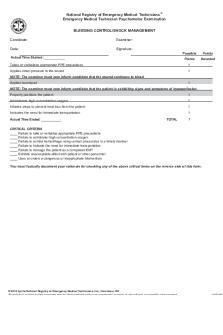Bleeding Disorders Final PDF

| Title | Bleeding Disorders Final |
|---|---|
| Author | Doctor Steven Strange |
| Course | Hematology 2 |
| Institution | Our Lady of Fatima University |
| Pages | 5 |
| File Size | 440.2 KB |
| File Type | |
| Total Downloads | 411 |
| Total Views | 657 |
Summary
Function: o To arrest bleeding at the site of injury or blood loss by forming a hemostatic plug. o To remove the hemostatic plug when healing is complete. o To maintain blood in a fluid state w/in the vascular system. Normal Hemostasis in terms of: o Clot-free; Liquid state o w/in the blood vessel o...
Description
SUMMARY OF HEMOSTASIS AND LAB EVALUATION NORMAL HEMOSTASIS Function: o To arrest bleeding at the site of injury or blood loss by forming a hemostatic plug. o To remove the hemostatic plug when healing is complete. o To maintain blood in a fluid state w/in the vascular system. Normal Hemostasis in terms of: o Clot-free; Liquid state o w/in the blood vessel o should be in normal flow: AXIAL FLOW LAMINAR FLOW Middle Peripheral Occupied w/ cells Occupied w/ plasma Rapid flow Slow flow 4 Components: 1.) Vascular/endothelium 2.) Platelets 3.) Coagulation 4.) Fibrinolysis
PLATELET AGGREAGATION
SECONDARY HEMOSTASIS COAGULATION CASCADE INTRINSIC PATHWAY EXTRINSIC PATHWAY Initiator: Tissue factor Initiator: Factor XII (endothelium) Utilizing CF: TENET Utilizing CF: VII APTT, PTT Prothrombin time COMMON PATHWAY X,V,II,I APTT,PTT,PT FIBRINOLYTIC SYSTEM Initiator: coagulation system LABORATORY EVALUATION
Bleeding time
Clotting time
Prothrombin time APTT Thrombin time Antithrombin Protein C & S
PRIMARY HEMOSTASIS *Activator: collagen from the endothelium during endothelial injury PLATELET Receptor: GP1b-IX ADHESION Pandikit: vWF (Source of vWF: endothelial cells, weibel palade bodies,
Tissue Factor Pathway Inhibitor D-dimer test
an assess blood vessel but it is usually used to test platelet function assess clotting factors; nonspecific test Prolonged clotting clotting factor deficiency; pero hindi mo alam yung specific clotting factor deficient kaya you have do the Factor Assay assess Extrinsic & Common Pathway Clotting Factors assess Intrinsic & Common Pathway Clotting Factors indirectly measures Fibrinogen measured to know if you’re prone to thrombosis or not plasma protein; protein C is activated by thrombomodulinthrombin complex with cofactor as forming activated protein C which will inhibit Factor Va and Factor VIIIa secreted by the endothelium, inhibits tissue factor/Factor VII deep vein thrombosis if prolonged
1
DISORDERS OF
megakaryocytes) – PVTBF (growth factors) Dense – CHAPS (calcium, ATP, ADP) Receptor: GPIIb-IIIa Pandikit/intracellular bridge: Fibrinogen Platelets→Aggregation: GPVa
Page
HEMATOLOGY II HEMOSTASIS
PLATELET SECRETION
Tendencies for thrombosis
PLATELET COUNT DIRECT METHODOLOGIES REESE & ECKER WBC BCB Blood then diluting fluid GUY & LEEKE RBC CV Diluting fluid then blood BECKER & CONCRITE Phase contrast microscopy 1% NH4 Oxalate AUTOMATION 1.) electrical impedance 2.) flow cytometry/ light scatter 3.) radio frequency INDIRECT METHODOLOGIES FONIO Wright stain 14% MgSO4 TOCANTINE Arterial is possible OLEF BCB Normal Platelet count Bleeding time is prolonged even if the function of platelets is normal Thrombocytosis Thrombocytosis Thrombocytopenia Trauma induced bleeding Spontaneous Bleeding due to platelet problems
150,000 – 500,000 500,000 1,000,000...
Similar Free PDFs

Bleeding Disorders Final
- 5 Pages

Clotting Time & Bleeding Time
- 3 Pages

Bleeding Time Essay
- 3 Pages

Musculoskeletal Disorders
- 40 Pages

Psychological Disorders
- 27 Pages

Clinical Core Tutorial - PR Bleeding
- 11 Pages

On the Sidewalk Bleeding. PDF
- 8 Pages

Haemodynamic Disorders
- 4 Pages

Dissociative Disorders
- 6 Pages

Personality Disorders
- 5 Pages

Disorders quiz
- 2 Pages

Clinical Disorders
- 20 Pages
Popular Institutions
- Tinajero National High School - Annex
- Politeknik Caltex Riau
- Yokohama City University
- SGT University
- University of Al-Qadisiyah
- Divine Word College of Vigan
- Techniek College Rotterdam
- Universidade de Santiago
- Universiti Teknologi MARA Cawangan Johor Kampus Pasir Gudang
- Poltekkes Kemenkes Yogyakarta
- Baguio City National High School
- Colegio san marcos
- preparatoria uno
- Centro de Bachillerato Tecnológico Industrial y de Servicios No. 107
- Dalian Maritime University
- Quang Trung Secondary School
- Colegio Tecnológico en Informática
- Corporación Regional de Educación Superior
- Grupo CEDVA
- Dar Al Uloom University
- Centro de Estudios Preuniversitarios de la Universidad Nacional de Ingeniería
- 上智大学
- Aakash International School, Nuna Majara
- San Felipe Neri Catholic School
- Kang Chiao International School - New Taipei City
- Misamis Occidental National High School
- Institución Educativa Escuela Normal Juan Ladrilleros
- Kolehiyo ng Pantukan
- Batanes State College
- Instituto Continental
- Sekolah Menengah Kejuruan Kesehatan Kaltara (Tarakan)
- Colegio de La Inmaculada Concepcion - Cebu



